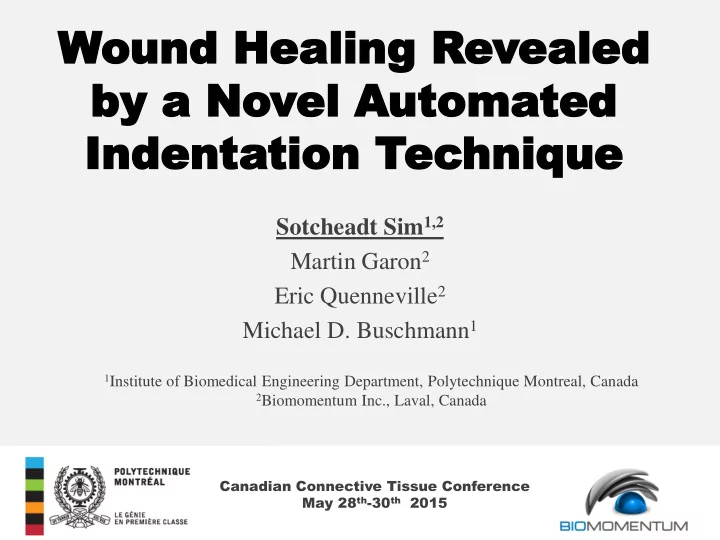

Wound ound Healing Healing Revealed ealed by a by a No Novel el Automa utomated ted Indent Indentation tion Tec echnique hnique Sotcheadt Sim 1,2 Martin Garon 2 Eric Quenneville 2 Michael D. Buschmann 1 1 Institute of Biomedical Engineering Department, Polytechnique Montreal, Canada 2 Biomomentum Inc., Laval, Canada Canadian Connective Tissue Conference May 28 th -30 th 2015
D isclosure Eric Quenneville and Martin Garon are the cofounders of the company Biomomentum Inc.
I ntroduction The desire in wound healing is to regenerate tissues in a manner that the functional and structural properties of the wounded tissue are restored. Additionally, the appearance of the scar shall be intact. Images taken from www.dillerlaw.com
I ntroduction Additionally, there is a desire to reduce the appearance of the scar. Images taken from www.dillerlaw.com
I ntroduction Conventional mechanical test Sample Excised strips Uniaxial tensile tests Invasive Disruptive Only tensile test as an indicator of the wound healing state is insufficient
I ntroduction Proposed mechanical test Sample Indentation tests Non-destructive Preserves the integrity of the surrounding tissue of the wound while testing
I ntroduction In this study, we wanted to test the ability of a novel automated indentation technique to non- destructively characterize mechanical properties of the entire wound and its integration with the surrounding skin.
M ethods Samples • 2 wounded pig skin samples • Size: 4 x 8 cm • Centered 3 cm incision length
M ethods Mechanically controlled surface mapping Conversion of position Camera-registration Position grid Top view image coordinates system superimposed pixels into metrics
M ethods Automated Indentation Equipment Multiaxial mechanical tester Spherical indenter Mach-1 v500css diameter=6.35mm Biomomentum Inc.
M ethods Excision of strips for tensile test Excised dumbbell-shape strips were taken adjacent to each other in a vertical plane
M ethods Indentation at each position Non-invasive thickness measurement was performed by finding the contact of the skin surface at each position prior to indentation Indentation tests at each position Indentation amplitude of 1.7 mm at 0.2 mm/s
M ethods Uniaxial tensile test Each strip was installed in fixtures and then mounted on the chamber plate of the mechanical tester The mechanical tester applied a gradually increasing tensile load until tissue rupture
R esults Mapping of maximum load and thickness High-resolution mapping of maximum load and thickness were generated (about 30s per position ). These mappings revealed significant spatial variation of the mechanical properties and thickness over the wound region compared to the uniform properties of the intact skin observed at least 1cm away from the incision site.
R esults Quantitative assessment Scar A Softer scar tissue (region I) Maximum Load Thickness than the surrounding skin (region II and region III). Region I 3.2 ± 2.4 N (n=36) 5.0 ± 0.6 mm (n=36) For the thickness, the scar is Region II 6.3 ± 6.0 N (n=53) 4.2 ± 0.6 mm (n=53) found thicker (region I) with a progressive thinner tissue Regon III 13.3 ± 5.3 N (n=72) 3.5 ± 0.2 mm (n=72) in region II and in region III.
R esults Quantitative assessment Scar B Maximum Load Thickness The mechanical properties of region I and region II are Region I 11.7 ± 6.7 N (n=35) 3.5 ± 0.3 mm (n=34) higher than region III . Region II 12.4 ± 8.1 N (n=19) 3.6 ± 0.3 mm (n=19) The thickness of all three regions are similar. Regon III 6.7 ± 2.9 N (n=13) 3.6 ± 0.1 mm (n=12)
R esults Quantitative hypertrophy/atrophy through thickness Top view section Cross- Scar A revealed a 12.25 mm 2 /mm of wound hypertrophy while scar B does not reveal significant hypertrophy
R esults Load at rupture Tensile Load at rupture (g) Scar A-a 2053 Scar A-b 2266 Scar B-a 2922 Scar B-b 3729
R esults Indentation vs Tensile properties Tensile Indentation Load at rupture (g) Maximum Load Thickness (N) (mm) Scar A-a 2053 1.71 5.08 Scar A-b 2266 3.21 4.80 Scar B-a 2922 7.13 3.87 Scar B-b 3729 12.79 3.49 A trend could be observed between the thickness and the maximum load obtained in indentation and the load at rupture obtained in tension. As the sample is thinner a higher load in indentation and at rupture As the sample is thicker a lower load in indentation and at rupture
C onclusion These preliminary results indicate that performing different mechanical tests on wounded skin samples provide complementary information to quantify the healing outcomes. Tension rupture test provides insight on the basic mechanical function of the scar along its surface (maintaining the wound closed). Novel automated indentation mapping technique was able to reveal the spatial variation in the compressive stiffness and thickness of the scar and its surrounding. These mappings could be used to quantify other characteristics of the scar like an hypertrophic healing or the presence of stiffer scar tissue.
C onclusion • Since the novel technique is non-destructive for the sample, it allows additional analyses (tensile, relaxation or shear mechanical tests, histology or biochemical assessment) to be performed at matched positions. • This high spatial resolution and non-destructive technique provides new opportunities when studying wound healing where the number of animals involved could be significantly reduced.
A knowledgements Funding provided by the National Sciences and Engineering Research Council (NSERC).
Q uestions
Recommend
More recommend